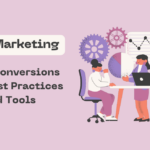
The Role of Quality Backlinks in SEO Success
August 5, 2024
CRO Marketing: Boost Conversions with Best Practices and Tools
September 13, 2024Starting a small business is like embarking on a new adventure. It offers the freedom to pursue your passions, create your own schedule, and, potentially, earn substantial rewards. But let’s face it—navigating the path to becoming a business owner can be daunting. From brainstorming ideas to managing growth, each step requires careful planning and execution. This guide will help simplify the process and set you on the path to success.
Step 1: Develop Your Business Idea
Identifying a Business Opportunity
The first step in starting a small business is finding an idea that resonates with you. Think about what problems you can solve or what needs are not being met. This could be anything from a new product innovation to a unique service offering.
Conducting Market Research
Once you have a business idea, it’s time to dive into market research. This involves studying your target audience, understanding your competitors, and assessing the demand for your product or service. Market research helps validate your idea and provides insights into potential challenges and opportunities.
Evaluating Your Business Idea
After gathering data, evaluate whether your business idea is viable. Consider factors like market demand, profitability, and your personal passion. Ask yourself: Is this something I’m excited about? Can I realistically make this work?
Step 2: Create a Business Plan
Purpose of a Business Plan
A business plan is your roadmap to success. It outlines your business goals, strategies, and financial forecasts. A well-crafted business plan not only helps you stay on track but also attracts investors and lenders.
Key Components of a Business Plan
Executive Summary
The executive summary is a snapshot of your business. It includes your business name, location, and the products or services you offer. It should also highlight your mission statement and basic financial projections.
Business Description
This section provides detailed information about your business. Describe what you do, who your customers are, and what sets you apart from the competition.
Market Analysis
Here, you delve into your industry, market size, and competition. Provide data and insights on market trends and customer needs.
Organization and Management
Outline your business structure and introduce your team. Include details about ownership, management roles, and your organizational structure.
Products or Services
Describe what you’re selling or the services you’re offering. Explain the benefits and features of your products or services.
Marketing and Sales Strategy
Detail how you plan to attract and retain customers. Discuss your marketing channels, sales tactics, and promotional strategies.
Financial Projections
Include financial forecasts, such as income statements, cash flow statements, and balance sheets. This section helps you and potential investors understand your financial outlook.
Step 3: Choose a Business Structure
Sole Proprietorship
A sole proprietorship is the simplest business structure. It’s easy to set up and gives you complete control over your business. However, it also means you’re personally liable for any debts or legal issues.
Partnership
A partnership involves two or more people sharing ownership. It’s relatively easy to establish but requires a clear partnership agreement to avoid disputes.
Corporation
A corporation is a more complex structure with its own legal identity. It offers protection against personal liability but involves more regulatory requirements.
Limited Liability Company (LLC)
An LLC combines the benefits of a corporation and a partnership. It provides liability protection while allowing flexible management and tax options.
Step 4: Register Your Business
Choosing a Business Name
Your business name should be memorable and reflective of your brand. It’s worth investing time in selecting a name that stands out and aligns with your business values.
Registering Your Business Name
Register your business name with the appropriate authorities. This may include registering a “Doing Business As” (DBA) name if it differs from your legal business name.
Obtaining Necessary Licenses and Permits
Depending on your business type and location, you may need various licenses and permits. Check local regulations to ensure you’re compliant with legal requirements.
Step 5: Secure Financing
Assessing Your Financial Needs
Determine how much capital you need to start and sustain your business. This includes startup costs, operational expenses, and any unforeseen expenses.
Exploring Funding Options
Personal Savings
Using your savings is a straightforward way to fund your business, but it requires careful financial planning.
Bank Loans
Traditional bank loans can provide substantial funding but often come with strict requirements and repayment terms.
Venture Capital
Venture capitalists invest in high-potential startups in exchange for equity. This can be a viable option if you have a scalable business model.
Crowdfunding
Crowdfunding platforms allow you to raise small amounts of money from a large number of people. It’s an excellent way to gauge interest and secure initial funding.
Step 6: Set Up Your Business Location
Home-Based Business
Starting a business from home is cost-effective and convenient. However, it requires discipline and a dedicated workspace.
Renting Office Space
Renting office space offers a professional environment and can be essential for businesses that need to meet clients or require more room.
Retail Locations
If your business involves selling products, a retail location might be necessary. Choose a location with high foot traffic and visibility.
Step 7: Establish Your Brand
Designing a Logo
A well-designed logo is a cornerstone of your brand identity. It should be unique, memorable, and reflect your business values.
Developing a Brand Identity
Create a cohesive brand identity that includes your logo, color scheme, and messaging. This helps build recognition and trust with your customers.
Building an Online Presence
In today’s digital age, having an online presence is crucial. Build a professional website, engage on social media, and consider online advertising to reach your target audience.
Step 8: Launch Your Business
Preparing for Launch Day
Plan a launch strategy that includes a marketing campaign, special promotions, and any events to create buzz around your business.
Marketing Your Business
Effective marketing is key to attracting customers. Use a mix of online and offline strategies to reach your audience and build brand awareness.
Networking and Building Relationships
Building relationships with other businesses and professionals can provide valuable opportunities and support. Attend industry events and join relevant groups to expand your network.
Step 9: Manage and Grow Your Business
Tracking Your Business Performance
Monitor key performance indicators (KPIs) to track your business’s success. Regularly review financial statements, sales data, and customer feedback.
Adapting to Market Changes
Stay flexible and be prepared to adapt your strategies based on market trends and feedback. Innovation and responsiveness can help you stay competitive.
Planning for Growth
As your business grows, plan for scaling up. This might involve expanding your product line, entering new markets, or increasing your team.
Conclusion
Starting a small business is an exciting endeavor that requires careful planning and execution. By following these steps, from developing a solid business idea to managing and growing your venture, you can set yourself up for success.




